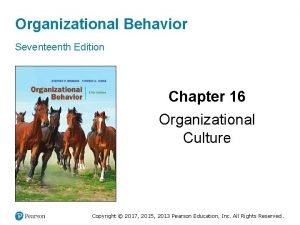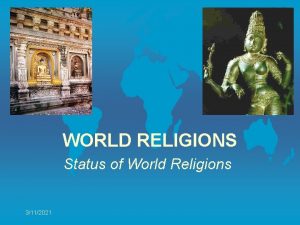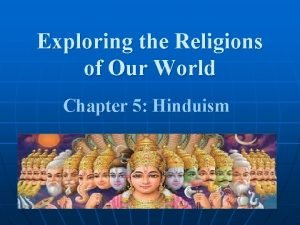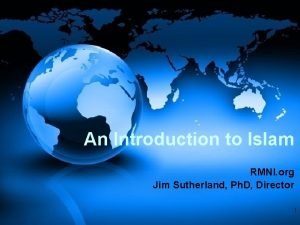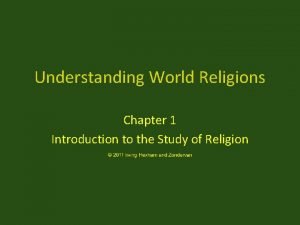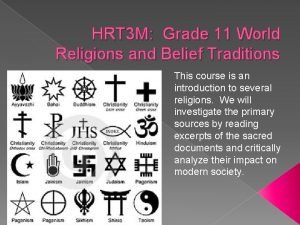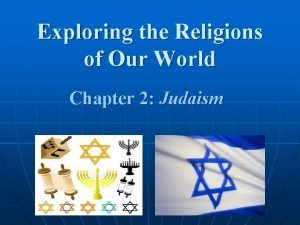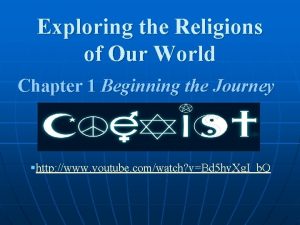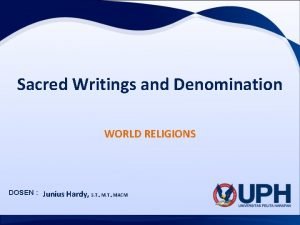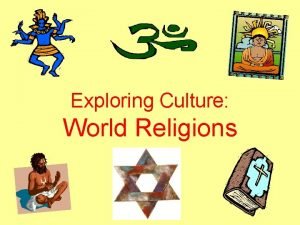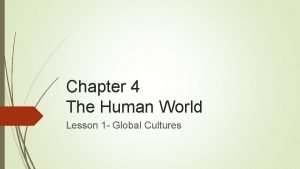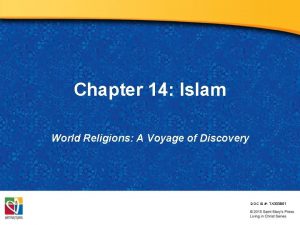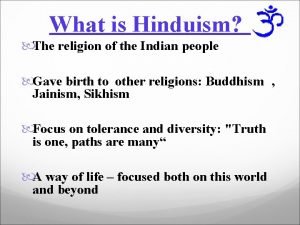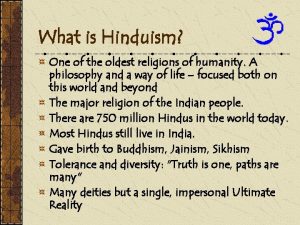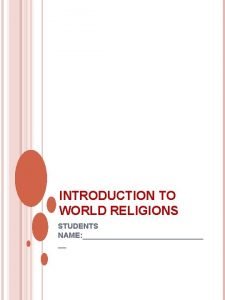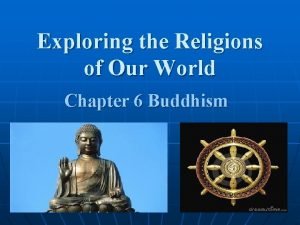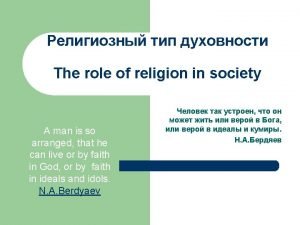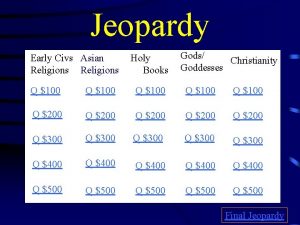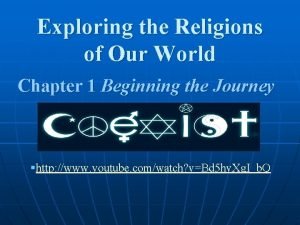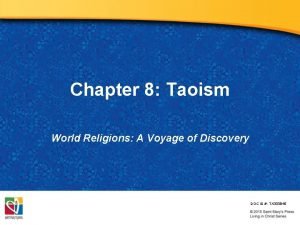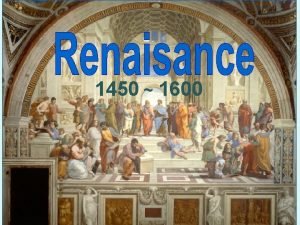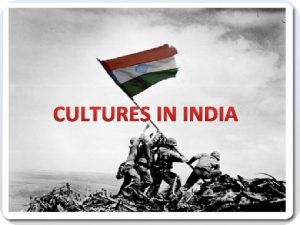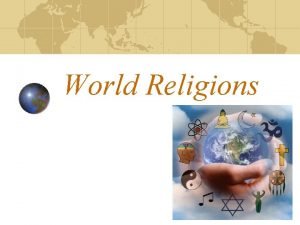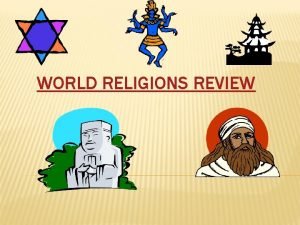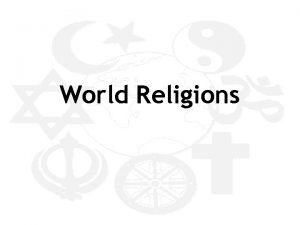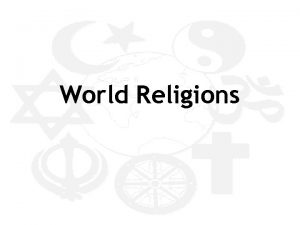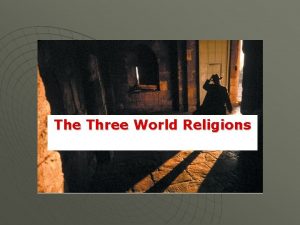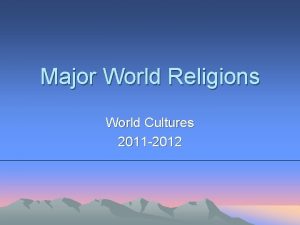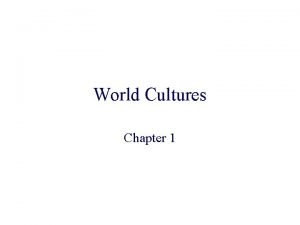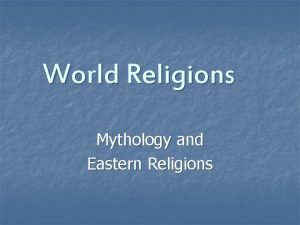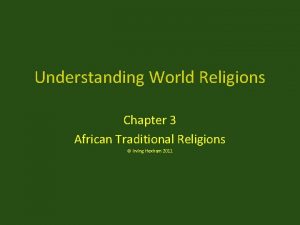World Religions and Cultures Up to 1450 Focus



































- Slides: 35

World Religions and Cultures Up to 1450

Focus • 1. What does it mean that religions give people “an ethical code to live by? ” • 2. How do religions influence gender roles? Give specific examples if you can!!! • 3. Do religions tend to support the existing social and political order, or challenge it? Give specific examples to back up your points!

Period 1 Religions Review • Up to 600 C. E. • Paleolithic – animism • Burial sites indicate belief in afterlife • Early Civilizations • Vedic religion Hinduism • Hebrew monotheism Judaism • Zoroastrianism influence Christianity

Period 2 Religions Overview (600 B. C. E. to 600 C. E. ) • Codification and development of existing belief systems • Judaism • Hinduism • * Both these religions have origins that predate Classical Era • New belief systems and cultural traditions • • • Christianity Buddhism Daoism Confucianism Greco-Roman Rationalism • * Why so many new belief systems around same time?

Period 3 Religions Overview (600 to 1450) • CHANGE • New Religion= ISLAM • Founded in 622 C. E. • Rapid spread throughout Middle East, North Africa, Southern Europe, East and West Africa, and South Asia • Defeated Persian Empire and took half of Byzantine • Crusades: 1095 C. E. • CONTINUITY • Persistence of animism and shamanism • Continued diffusion of Christianity, Buddhism, and Hinduism • Jewish diasporic communities – trade • Human sacrifice in Americas, expanded by Aztecs

Hinduism India (spread to SE Asia) Vedas brought by Aryans Codified in Sanskrit 500 BCE No founder; very diverse Brahman – supreme soul Karma (actions), Dharma (duties), Reincarnation (rebirth), Moksha (one with universe) • Caste System – rigid social system • Patriarchal • Major continuity in India • • •

Caste System • Four varnas (castes) based on part of Purusha • The Brahmins: priests and scholars • The Kshatriyas: kings, governors, warriors and soldiers • The Vaishyas: cattle herders, agriculturists, artisans and merchants • The Shudras: laborers and service providers • Discouraged rebellion and justified social and political status quo

Buddhism • Founder - Siddhartha Gautama in India • Core beliefs- 4 Noble Truths (suffering and desire); eight-fold path (“right life”) • Recorded by his followers into sutras • reaction to the Vedic beliefs and rituals dominant in South Asia • Accepted karma, dharma, and reincarnation, rejected caste system • Nirvana – accessible to everyone in this lifetime

Diffusion of Buddhism • Universal religion – sought converts • Appealed to women and poor • Changed over time as it spread throughout Asia • First through the support of the Mauryan Emperor Ashoka • Then through the efforts of missionaries and merchants and establishment of educational institutions

Diffusion of Buddhism

Theravada and Mahayana • Theravada (Teachings of the Elders): nirvana is a personal quest that few can achieve; Buddha is not divine. • Mahayana (Great Vehicle): offered help on the way to nirvana, especially from bodhisattvas—spiritually developed people who postponed their own journey to nirvana to help those still suffering; transformed Buddhism into popular religion of salvation.

Theravada v. Mahayana

Which would you guess these are? Japan, 8 th century Amitabha Buddha, 12 th 14 th centuries

Which would you guess these are? Northwest India, 2 nd century C. E.

China • After decline of Zhou Dynasty, China experienced the Era of Warring States (403— 221 B. C. E. ) • Disorder and turmoil • Chinese thinkers sought ways to restore the order and tranquility of earlier times, though they arrived at very different answers.

Legalism • The solution: rules and laws, enforced through a system of rewards and punishments. • Most people are stupid and shortsighted; they need a strong state. • Justified harsh reunification of China under Shihuangdi in the Qin Dynasty.

Confucianism • The solution: moral example of superiors. • Lessons of Confucius elaborated by key disciples • Sought to promote social harmony by outlining proper rituals and social relationships for all people in China, including the rulers. • Ren (goodness, nobility of heart) could be cultivated through education and ceremony. • Filial piety – honoring one’s ancestors and parents. • Embraced by Chinese government starting with Han; provided social order and stability • Major continuity in China

Daoism • The solution: withdraw from politics into the world of nature. • Dao= the way of nature • Laozi wrote the Daodejing, elaborated by Zhuangzi • Core belief of balance between humans and nature • Assumed Chinese political system would be altered indirectly

Influence of Daoism on Chinese Culture • • Medical theories and practices Poetry Metallurgy Architecture

Zoroastrianism • 600 s B. C. E: Persian prophet Zarathustra began to preach a monotheistic religion pitting good against evil. • Ahura Mazda (God of goodness and light) verses Angra Mainyu (forces of evil) • A savior would aide Ahura Mazda’s ultimate victory • Day of judgment- those who had chosen Ahura Mazda would be resurrected and rewarded with eternal life • Eventually died out as a major religion, but its influences can be seen in Judaism, and subsequently Christianity and Islam.

Judaism • • • Began in Middle East Founder: Abraham 1 st Monotheistic Covenant/agreement with God Torah (holy book) codified 500 BCE • Further developed the association of monotheism with Judaism • Also reflected the influence of Mesopotamian cultural and legal traditions

Jewish Diaspora • The Assyrian, Babylonian, and Roman empires conquered various Jewish states • 772 B. C. E. - conquered by Assyria • 586 B. C. E - fell to Babylonians • 70 C. E. – Romans destroy temple • Contributed to growth of Jewish diasporic communities around the Mediterranean and Middle East. • Diaspora: migration of people from established homeland

Jewish Diaspora

Christianity • Founder: Jesus 30 CE • Based on teachings and divinity of Jesus of Nazareth as recorded by his disciples • Drew on Judaism • Initially rejected Roman and Hellenistic influences • 1 st persecuted by Romans, become official religion of empire in 380 CE Constantine • Universal religion: spread through missionaries (St. Paul), trade, Roman Roads • Spreads throughout Mediterranean Region

Diffusion of Christianity

Comparing Christianity and Buddhism

Greco-Roman Rationalism • Core ideas: logic, empirical observation, and the nature of political power and hierarchy. • Established a secular tradition: separated science and philosophy from religion. • Socrates, Plato, Aristotle Verses

Philosophers • Socrates: Athenian philosopher known for questioning his student’s logic, put to death for criticizing government and “corrupting the youth” • Plato: concerned with ethics/government, The Republic: a good society would be ruled by a class of guardians led by a philosopher-king • Aristotle: student of Plato, taught Alexander the Great; “virtue” could be learned; wanted a mixed system of monarchy, aristocracy, and democracy

The Death of Socrates: Condemned to death by an Athenian jury, Socrates refused to go into exile, drinking a cup of poison hemlock and dying in 399 B. C. in the presence of his friends (Jacques-Louis David, 1787).

Religion and Gender • Belief systems affected gender roles • Buddhism and Christianity encouraged monastic life • Monastic life- living in religious orders apart from society • “Fun to be a nun” – nuns had more control over their daily lives than married women • Confucianism emphasized filial piety.

Continuity • Other religious and cultural traditions continued • Shamanism and animism continued to shape people’s lives because of their daily reliance on the natural world. • Ancestor veneration persisted in many regions. • • Africa The Mediterranean region East Asia The Andean areas

Literature and Drama • Literature, drama, architecture, and sculpture, show distinctive cultural developments. • Influenced artistic developments in neighboring regions and in later time periods • Greek plays • Indian epics Mask of Dionysus Ramayana: Rama (on Hanuman) battles demonking Ravana

Architecture • Indian • Greek • Roman

Syncretism • The convergence of Greco-Roman culture and Buddhist beliefs affected the development of unique sculptural developments. • Gandhara Buddhas exemplify a syncretism • Gandhara: region of today’s Afghanistan/Pakistan • Syncretism: combining or merging discrete traditions or contrary beliefs • Hellenistic veneration for the body is combined with Buddhist symbols • 1 st-2 nd century C. E.

 Organizational behavior
Organizational behavior 5 major world religions and their founders
5 major world religions and their founders Cost focus and differentiation focus
Cost focus and differentiation focus Drivers of differentiation
Drivers of differentiation 1450*3
1450*3 World map 1450
World map 1450 World religions map 2021
World religions map 2021 Exploring religions chapter 5 large
Exploring religions chapter 5 large Taliban vs western values ap human geography
Taliban vs western values ap human geography World religions percentage
World religions percentage World religions chapter 1
World religions chapter 1 Grade 11 world religions
Grade 11 world religions Exploring the religions of our world chapter 2 pdf
Exploring the religions of our world chapter 2 pdf Exploring the religions of our world chapter 1 pdf
Exploring the religions of our world chapter 1 pdf Religions in the world
Religions in the world Religions of the world
Religions of the world The human world lesson 1 global cultures
The human world lesson 1 global cultures Religions
Religions Religions of the world
Religions of the world Facts about hinduism
Facts about hinduism Religion
Religion Steyning primary school uniform
Steyning primary school uniform Relocation diffusion
Relocation diffusion Religions of the world
Religions of the world Religion
Religion What is the first religion in the world
What is the first religion in the world Religions of the world
Religions of the world Exploring religions chapter 6 large
Exploring religions chapter 6 large Religions of the world
Religions of the world Religions of the world
Religions of the world Religions of the world
Religions of the world World religions jeopardy
World religions jeopardy Exploring the religions of our world
Exploring the religions of our world World religions a voyage of discovery
World religions a voyage of discovery For adult
For adult Actor focus vs object focus
Actor focus vs object focus
